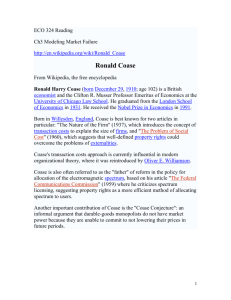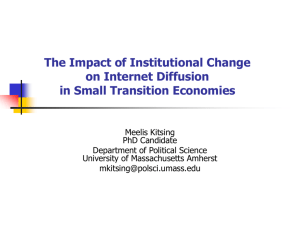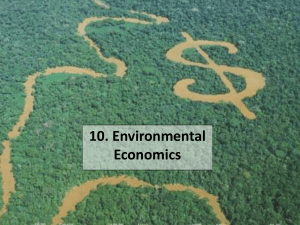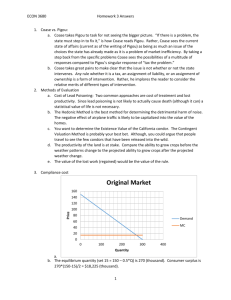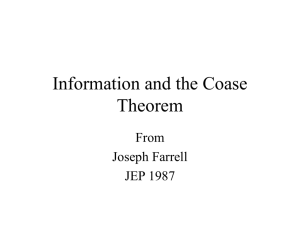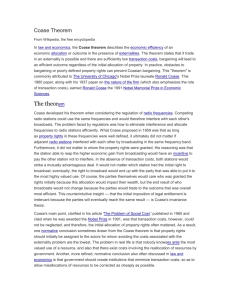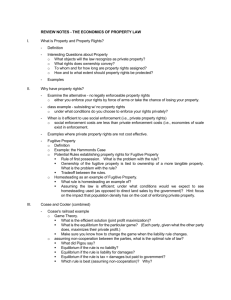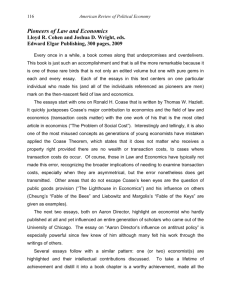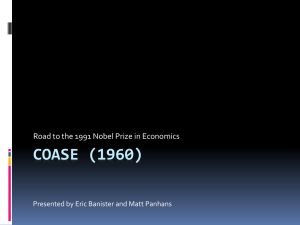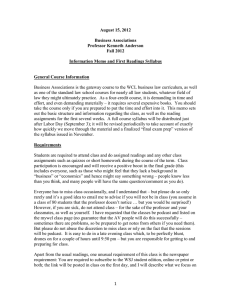Ronald Coase and the Misuse of Economics Page 1 of 5
advertisement
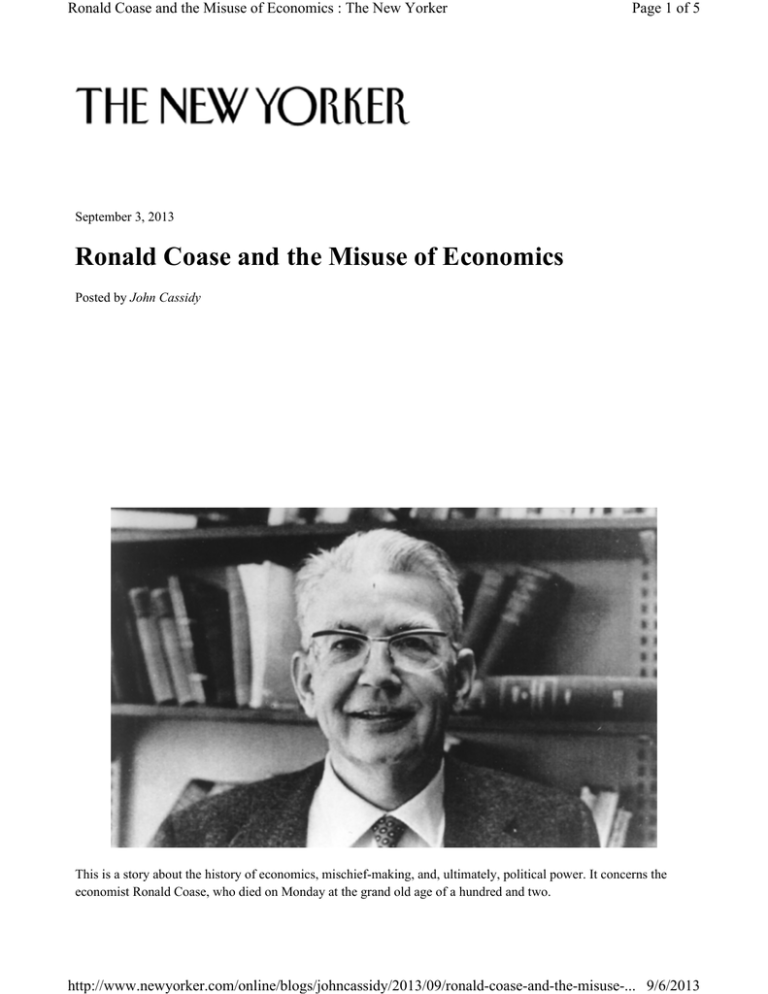
Ronald Coase and the Misuse of Economics : The New Yorker Page 1 of 5 September 3, 2013 Ronald Coase and the Misuse of Economics Posted by John Cassidy This is a story about the history of economics, mischief-making, and, ultimately, political power. It concerns the economist Ronald Coase, who died on Monday at the grand old age of a hundred and two. http://www.newyorker.com/online/blogs/johncassidy/2013/09/ronald-coase-and-the-misuse-... 9/6/2013 Ronald Coase and the Misuse of Economics : The New Yorker Page 2 of 5 During his lifetime, Coase, who was born in London’s Willesden neighborhood and educated in England before moving to America in 1951, was transformed into an icon of the political right. His famous “Coase theorem” was used to justify a hands-off approach to big business on the part of politicians, regulatory agencies, and judges, leaving pollution and other economic problems to the corrective powers of the free market. During the nineteenseventies and nineteen-eighties, when the Chicago School of economics was sweeping everything before it in Washington and in the nation’s courts, Coase’s work proved immensely influential. In 1991, the Swedes awarded him a Nobel Prize in Economics, just one of many honors he received. Which is all pretty ironic, or tragic, depending on how you look at things. As a conservatively inclined economist, Coase was instinctively skeptical of government regulations, but he was also an English empiricist who recognized that reality is complicated. He didn’t believe in laissez-faire, and he freely admitted that the Coase theorem didn’t apply to many cases of pollution and other instances of what economists refer to as “negative externalities,” especially those that affect large numbers of people. Indeed, Coase didn’t even think of the Coase theorem as a full-scale economic theory, but merely as a useful mental exercise that could be carried out before passing onto more realistic cases. It was left to less careful proselytizers to exploit Coase’s work in their crusades against big government. In their hands, his subtle reasoning was bowdlerized and distorted. With the aid of right-wing groups like the Olin Foundation, politicians who were doing the bidding of big businesses, and judges who thought they were applying the latest economic theory but were actually doing the same as the politicians, conservatives used Coase’s work to justify tipping the legal scales in favor of corporations, scrapping environmental regulations, and removing other restrictions on odious business behavior that had been imposed during the first three quarters of the twentieth century. It all began in the late nineteen-fifties, when Coase was thinking about an old problem in economics: how to deal with “those actions of business firms which have a harmful effect on others,” such as factories creating a lot of noise and emitting toxic gases. The standard solutions for these types of pollution were to encourage the people affected to hold the polluter liable in court, or to impose a tax on the activity that would discourage it. Coase, who had been an admirer of Adam Smith since his days as a student at the London School of Economics, said these approaches were wrong-headed. In a paper that was published in 1960, he wrote, “It is my contention that the suggested courses of action are inappropriate, in that they lead to results which are not necessarily, or even usually, desirable.” Why so? A careful reading of his paper, “The Problem of Social Cost,” shows that he was making two points, one theoretical and the other practical. Coase’s theoretical contribution was counter-intuitive. In an ideal world, he said, it wouldn’t really matter which party—the business or its neighbors—was held legally responsible for the act of pollution. As long as the two sides could sit down together with all the relevant facts and figures at hand, they could reach a socially acceptable agreement without any need for government assistance. To illustrate this, Coase used the example of a cattle farmer’s herd straying onto the cultivated fields of a neighboring grain farmer. If the law said the cattle farmer was legally responsible, then mostly likely he would end up paying for the cost of a new fence. If putting up a fence was prohibitively expensive, he might end up paying the grain farmer for the occasional damage to his crops. But what if the cattle farmer wasn’t legally responsible, perhaps because the property lines were unclear? In these circumstances, Coase said, the grain farmer would likely end up paying for a fence. Or, if the grain farmer believed that constructing a fence would be more costly than the occasional damage done by straying cattle, he would reluctantly accept the odd incursion. The assignment of property rights would determine who pays. But from a broader economic point of view, Coase argued, the outcome would essentially be the same, regardless. Based upon the relative costs of putting up fences and enduring occasional crop damage, the two sides would agree on an outcome that maximized the value of the http://www.newyorker.com/online/blogs/johncassidy/2013/09/ronald-coase-and-the-misuse-... 9/6/2013 Ronald Coase and the Misuse of Economics : The New Yorker Page 3 of 5 output (beef and grain) their farms produced. The allocation of resources to various types of production, and the value of the over-all production, would be the same. When Coase presented this argument to a group of economists at the University of Chicago, just one of them initially agreed with it. Twenty rejected it. But by the end of the evening, they were all on his side, which isn’t surprising. Coase’s conjecture is an application of the familiar laissez-faire supposition that in a perfect world, where all mutually beneficial bargains are exploited, the market outcome will be (Pareto) efficient—that is, it won’t be possible to improve upon it without reducing the welfare of at least one of the parties concerned. Once the free marketeers in Chicago realized this, they warmed to Coase. In 1964, he moved from the University of Virginia to the Windy City, where he was to live out his life. A couple of years later, George Stigler, one of the leading lights of the Chicago School, elevated Coase’s conjecture about property rights and bargaining, which had been expressed in commendably plain English, to the higher realm of theory, and coined the term “Coase theorem.” Once it was clad in this new, shiny wrapping, many conservative economists, policy wonks, and judges interpreted Coase’s work to say that as long as property rights were clearly specified, there was no need for government regulations, “sin taxes,” or punitive legal judgments. The magic of the market could be relied upon to produce a desirable outcome. Which, of course, isn’t what Coase had said at all. In his 1960 paper, he made clear that he was talking about a world in which the affected parties can come together, with all relevant information at hand, and reach a voluntary agreement at zero cost. “This is, of course, a very unrealistic assumption,” Coase wrote. In cases of industrial pollution, thousands of people, or even more, can be affected. Getting them together, and persuading them all to agree on a settlement, can be a monumental and very costly undertaking. Coase noted: Direct government regulation will not necessarily give better results than leaving the problem to be solved by the market or the firm. But equally there is no reason why, on occasion, such government administrative regulation should not lead to an improvement in economic efficiency. This would seem particularly likely when, as is normally the case with the smoke nuisance, a large number of people are involved, and in which therefore the costs of handling the problem through the market or the firm may be high. Corralling the victims isn’t the only problem. In many environmental cases, for example, there is no agreement on how extensive the damage is, or how much it would cost to rectify. Sometimes—take, for example, the long-term health implications of the radioactivity leak at Fukushima—this information isn’t just disputed: it doesn’t exist. We just don’t know how many people will get sick in the coming years as a consequence of being exposed to the radiation. Even if all the relevant information is available, there may be other problems. Confronting an opponent that is often fragmented and weak, big polluters have an incentive to stonewall, obfuscate, and exercise their influence over local politicians and judges. On the other side, the people affected by pollution have an incentive to wait for others to take the lead and then “free-ride” on their efforts. Even if the two sides do eventually square off in a bargaining session, there is no assurance that the outcome will be the most efficient one. Both sides still have an incentive to lie, distort, and engage in brinksmanship. Modern theoretical studies of bilateral bargaining suggest that in such circumstances, there are a range of possible outcomes, and many of them aren’t efficient in any sense of the word. In short, there is seldom any reason to suppose that letting the market deal with externalities will produce a good outcome. Of course, government-imposed solutions, such as zoning laws and limits on emissions, often have drawbacks, too. As Coase pointed out back in 1960, the only sensible way ahead is to look at the individual case carefully and decide which approach is likely to work best. If it’s a big, complicated dispute that involves thousands of different parties, regulation or taxation, or both, is often the best remedy. If it’s something smaller, with fewer people involved—a dispute about a noisy neighbor, say—the parties themselves might be able to work it out. http://www.newyorker.com/online/blogs/johncassidy/2013/09/ronald-coase-and-the-misuse-... 9/6/2013 Ronald Coase and the Misuse of Economics : The New Yorker Page 4 of 5 But that’s most decidedly not the message that the world took from Coase. Late in life, he would be reduced to gently complaining that people focussed on a few pages of his original 1960 paper—the bit dealing with an idealized world of effortless bargaining and zero “transactions costs”—and ignored the rest. In the lecture he gave upon receiving his Nobel, he said modestly, “I tend to regard the Coase theorem as a stepping stone on the way to an analysis of an economy with positive transaction costs.” By then, though, what Coase actually said didn’t make much difference. For the purposes of history, the soft-spoken boy from Willesden had been enlisted in a conservative counter-revolution that turned the United States (and many other countries) in a coarser, less regulated, and less equitable direction. Photograph: AP. Keywords • • • • bizpages; business; currency; politics Newsletters • This Week: Links to articles and Web-only features in your inbox every Monday. • Cartoons: A weekly note from the New Yorker's cartoon editor. • • http://www.newyorker.com/online/blogs/johncassidy/2013/09/ronald-coase-and-the-misuse-... 9/6/2013
